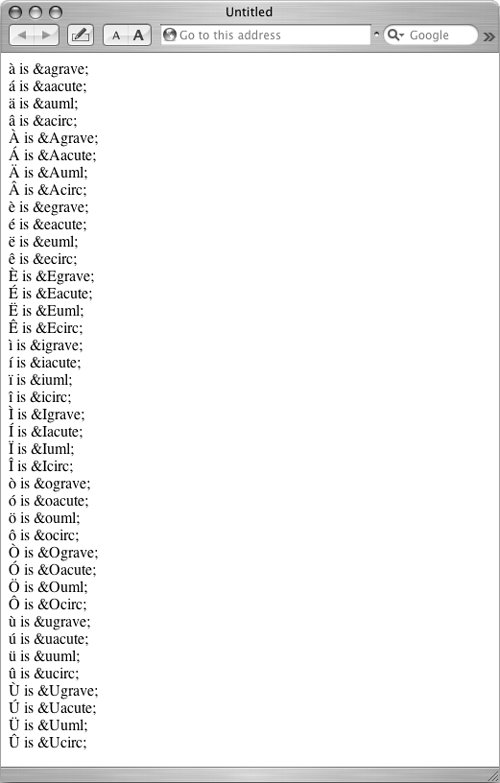Displaying ISO Latin Characters If you're authoring Web pages by hand, it can be a hassle to remember codes for different characters like and . Script 17.9 shows you a list of common variations of the vowels . Script 17.9. Rather than look up an accented character in a book, let JavaScript generate a list whenever you need one. | [View full width] javascript:var i,j,w,t='',v=new Array('a','A', 'e','E','i','I','o','O','u','U'),s=new  Array ('grave','acute','uml','circ');for(i=0; i<10;i++){for(j=0;j<4;j++){w=v[i]+s[j];t+= Array ('grave','acute','uml','circ');for(i=0; i<10;i++){for(j=0;j<4;j++){w=v[i]+s[j];t+=  '&'+w+' is &'+'amp;'+w+';<br/>';}}void (document.body.innerHTML=t); '&'+w+' is &'+'amp;'+w+';<br/>';}}void (document.body.innerHTML=t);
| To display ISO Latin characters: | 1. | javascript:var i,j,w,t='', Start off the bookmarklet by initializing four variables . | | 2. | v=new Array('a','A','e','E','i','I', 'o','O','u','U'), Initialize an array, v , which contains all the vowels. | | 3. | s=new Array('grave','acute','uml', 'circ'); Here's another array, s , which contains all the diacritical character codes. | | 4. | This line sets up i to loop through the v array. | | 5. | And this line sets up j to loop through the s array. | | 6. | In this line, we set up the variable w to be the vowel concatenated with the code. | | 7. | t+='&'+w+' is &'+'amp;'+w+';<br />'; So the output is the character, followed by the HTML code required to display that character. All of these codes are preceded by an ampersand (&). | | 8. | }}void(document.body.innerHTML=t); And finally, the document gets displayed, as shown in Figure 17.17 .  | |
